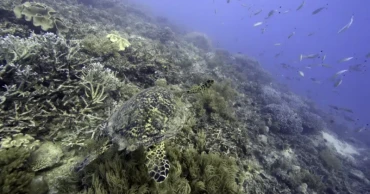Marine
Nations reach accord to protect marine life on high seas
For the first time, United Nations members have agreed on a unified treaty to protect biodiversity in the high seas - representing a turning point for vast stretches of the planet where conservation has previously been hampered by a confusing patchwork of laws.
The U.N. Convention on the Law of the Sea came into force in 1994, before marine biodiversity was a well-established concept. The treaty agreement concluded two weeks of talks in New York.
An updated framework to protect marine life in the regions outside national boundary waters, known as the high seas, had been in discussions for more than 20 years, but previous efforts to reach an agreement had repeatedly stalled. The unified agreement treaty, which applies to nearly half the planet's surface, was reached late Saturday.
“We only really have two major global commons — the atmosphere and the oceans,” said Georgetown marine biologist Rebecca Helm. While the oceans may draw less attention, “protecting this half of earth’s surface is absolutely critical to the health of our planet."
Nichola Clark, an oceans expert at the Pew Charitable Trusts who observed the talks in New York, called the long-awaited treaty text "a once-in-a-generation opportunity to protect the oceans — a major win for biodiversity."
The treaty will create a new body to manage conservation of ocean life and establish marine protected areas in the high seas. And Clark said that's critical to achieve the U.N. Biodiversity Conference’s recent pledge to protect 30% of the planet’s waters, as well as its land, for conservation.
Treaty negotiations initially were anticipated to conclude Friday, but stretched through the night and deep into Saturday. The crafting of the treaty, which at times looked in jeopardy, represents “a historic and overwhelming success for international marine protection,” said Steffi Lemke, Germany's environment minister.
“For the first time, we are getting a binding agreement for the high seas, which until now have hardly been protected,” Lemke said. “Comprehensive protection of endangered species and habitats is now finally possible on more than 40% of the Earth's surface.”
The treaty also establishes ground rules for conducting environmental impact assessments for commercial activities in the oceans.
“It means all activities planned for the high seas need to be looked at, though not all will go through a full assessment,” said Jessica Battle, an oceans governance expert at the Worldwide Fund for Nature.
Several marine species — including dolphins, whales, sea turtles and many fish — make long annual migrations, crossing national borders and the high seas. Efforts to protect them, along with human communities that rely on fishing or tourism related to marine life, have long proven difficult for international governing bodies.
“This treaty will help to knit together the different regional treaties to be able to address threats and concerns across species' ranges,” Battle said.
That protection also helps coastal biodiversity and economies, said Gladys Martínez de Lemos, executive director of the nonprofit Interamerican Association for Environmental Defense focusing on environmental issues across Latin America.
“Governments have taken an important step that strengthens the legal protection of two-thirds of the ocean and with it marine biodiversity and the livelihoods of coastal communities,” she said.
The question now is how well the ambitious treaty will be implemented.
Formal adoption also remains outstanding, with numerous conservationists and environmental groups vowing to watch closely.
The high seas have long suffered exploitation due to commercial fishing and mining, as well as pollution from chemicals and plastics. The new agreement is about “acknowledging that the ocean is not a limitless resource, and it requires global cooperation to use the ocean sustainably,” Rutgers University biologist Malin Pinsky said.
2 years ago
Five killed in California Marine aircraft crash identified
The U.S. Marine Corps on Friday identified five people who died when their Osprey tiltrotor aircraft crashed during training in the California desert.
Killed were two pilots: Capt. Nicholas P. Losapio, 31, of Rockingham, New Hampshire and Capt. John J. Sax, 33, of Placer, California.
Also killed were three tiltrotor crew chiefs: Cpl. Nathan E. Carlson, 21, of Winnebago, Illinois; Cpl. Seth D. Rasmuson, 21, of Johnson, Wyoming and Lance Cpl. Evan A. Strickland, 19, of Valencia, New Mexico.
The longest-serving Marine was Losapio, with 8 years and 9 months, while Strickland had been in the service for 1 year and 7 months
The MV-22 Osprey went down Wednesday afternoon during training in a remote area in Imperial County near the community of Glamis, about 115 miles (185 kilometers) east of San Diego and about 50 miles (80 kilometers) from Yuma, Arizona.
The Marines were based at Camp Pendleton and assigned to Marine Medium Tiltrotor Squadron 364 of Marine Aircraft Group 39, part of the 3rd Marine Aircraft Wing headquartered at Marine Corps Air Station Miramar in San Diego.
“It is with heavy hearts that we mourn the loss of five Marines from the Purple Fox family” the squadron's commanding officer, Lt. Col. John C. Miller, said in a statement. “Our primary mission now is taking care of the family members of our fallen Marines and we respectfully request privacy for their families as they navigate this difficult time."
The cause of the crash is under investigation.
The Marines were participating in routine live-fire training over their gunnery range in the Imperial Valley desert, said Marine Maj. Mason Englehart, spokesperson for the 3rd Marine Aircraft Wing.
READ: Light aircraft crashes in Russia
The Osprey, a hybrid airplane and helicopter, flew in the wars in Iraq and Afghanistan but has been criticized by some as unsafe. It is designed to take off like a helicopter, rotate its propellers to a horizontal position and cruise like an airplane.
Versions of the aircraft are flown by the Marine Corps, Navy and Air Force.
Prior to Wednesday’s crash, Osprey crashes had caused 46 deaths, the Los Angeles Times reported.
Most recently, four Marines were killed when a Marine Corps Osprey crashed on March 18 near a Norwegian town in the Arctic Circle while participating in a NATO exercise.
3 years ago
Marine fisheries policy designed for proper sea fish production
The government has drafted the national marine fisheries policy for the sustainable conservation, management and extraction of marine fish in the country’s vast sea areas.
4 years ago




